Knowing how to cut crown molding is not one of the things that most people struggle with. Even after years of practice. There are ways to make it easier. I’ve already shared how to create Crown Moulding Templates which is a great option because it allows you to cut almost any size crown moulding with almost any miter saw. Using a cutting guide can make cutting small crown molding like what you would install on furniture or cabinets — as easy as slicing cream pie!
How to cut Crown Molding
I generally only use small crown moulding for furniture but the cuts are the same as for wall/ceilings. A compound miter cut = making a cut that is both mitered and beveled. With a crown moulding that is small enough to sit on your saw, resting against your fence at the same angle on which it would rest against your wall, you only have to miter! (Because the way the moulding is sitting on your saw creates the bevel WHILE you cut a miter.) Woohoo!
You can purchase crown moulding stops for a lot of miter saws. I bought some for my DeWalt saw but I was never happy with them. The problem with them (as with most manufactured crown stops), is that they only support a small portion of the crown moulding on each side of the saw, allowing the moulding to move out of the correct position before or WHILE making the cuts. Pointless!
I have found that a piece of scrap wood and your trusty Carpet Tape (No shop is complete without it) is a quick and easy way to make a customized crown stop and cutting guide that will help you make practically perfect cuts every time!
Crown Moulding Stop and Cutting Guide
Set up Crown Stop position
- Set the crown moulding against the fence, upside down at a proper angle.
- Use painters tape to mark where the crown sits on the saw base. Apply
- carpet tape to the saw platform — outside the swivel area. We don’t want the tape holding the saw up when you’re trying to set the miter angle. 🙂 Make sure not to get carpet tape in front of the painters tape; in line with or behind it is great.
- Remove the backing on the carpet tape and secure the template board to the saw. Be sure to line the top of the board up with the blue painters tape.
Cut and Label Cutting Guide
With the board secured to the saw, you are going to make three cuts. Don’t cut through the board, just cut small slits into the board as shown in the photo below. 🙂
- 45˚ to both the right and left
- Make a straight cut 0˚
Label
- In big, bold letters write, “Crown UPSIDE down“. As seen in the photo above. This is so you always remember that every – single – time, the crown is placed upside down against the fence on your saw. (The bottom of the crown moulding is the decorative part — generally.)
- Label the right side of the board as shown in the photo below.
- Label the left side of the board as shown below.
Cutting your Crown Moulding
Now you have a little recessed area all the way across your saw that your crown moulding nestles right into perfectly. The board is your “crown stop”. It holds your crown moulding exactly the right distance away from the fence keeping it in the right angle while you make your cuts. The Cutting guide reminds you how and where to cut as well as which side of the crown moulding you need to keep for the corner you are cutting. It gets very confusing so constant reminders are very helpful!
When cutting with this method — with the crown moulding UPSIDE DOWN, angled against the fence:
Outside Corners
- The left side of the crown piece will be the right side of the corner.
- The right side of the crown piece will be the left side of the corner.
Inside Corners
- The left side of the crown piece will be the left side of the corner.
- The right side of the crown piece will be the right side of the corner.
This confusing confundication is why labeling “Keep R piece”, or “Keep L piece” is so important.
*Whenever I cut moulding, I always try to err on the side of being too long on my initial cut. Shaving off a bit more is easier than starting over with a new piece of moulding because I cut too short!
*Since the crown moulding is always upside down, always make your mark on the bottom of the crown.
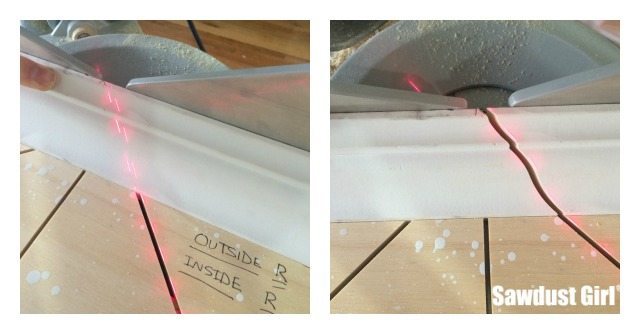
*When making straight cuts (for places where the crown moulding ends), instead of removing the cutting jig, simply lay the crown flat against the fence or lay it down on the jig.
*You will not be able to use the same “stop and guide” board for different sized crown moulding. I keep the last one I used only so I can copy the instructions onto the new one — because that’s a lot faster than thinking through it each time. It gets so confusing…which is why I use the Templates and Cutting Guide in the first place! 🙂

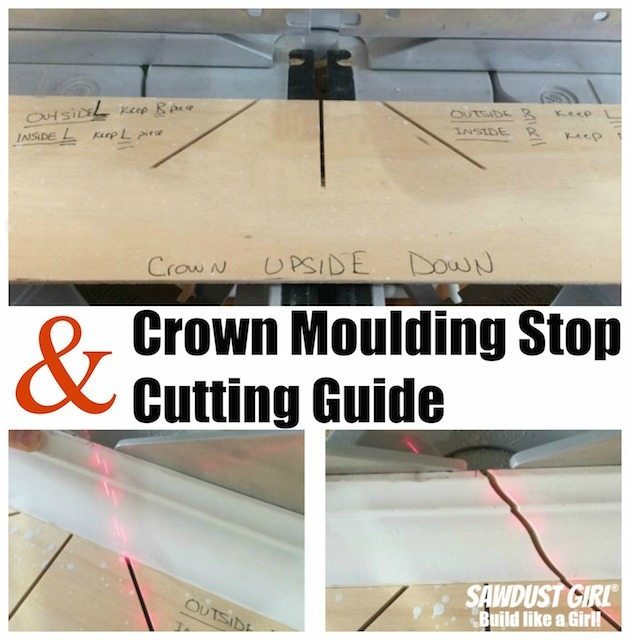
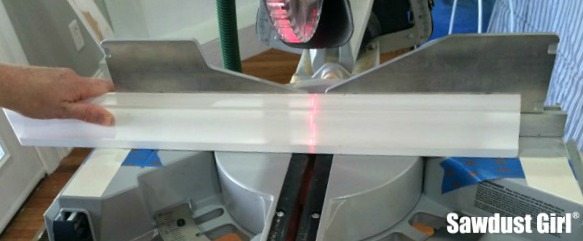
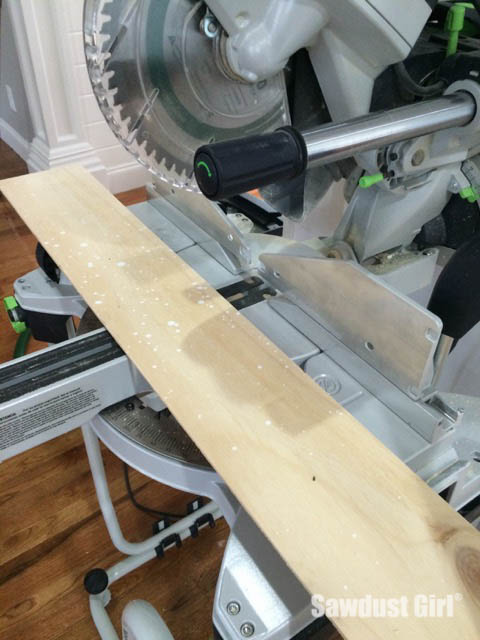
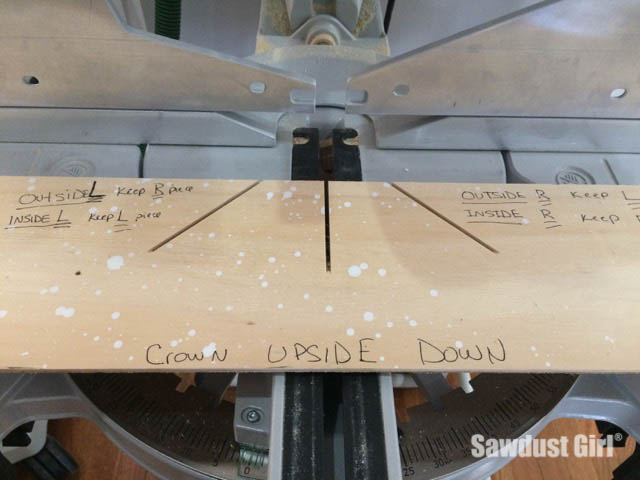
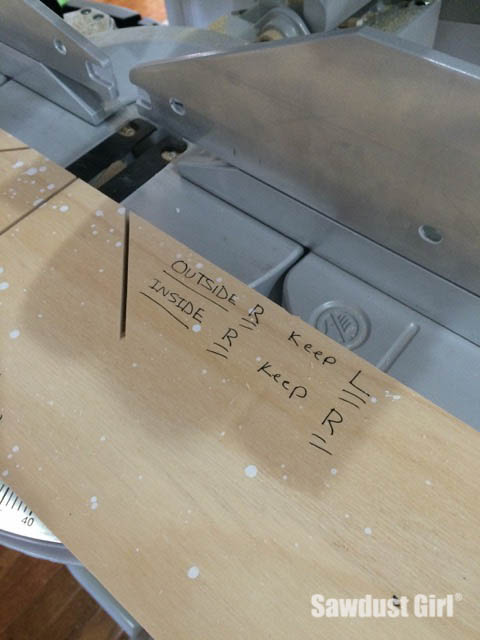
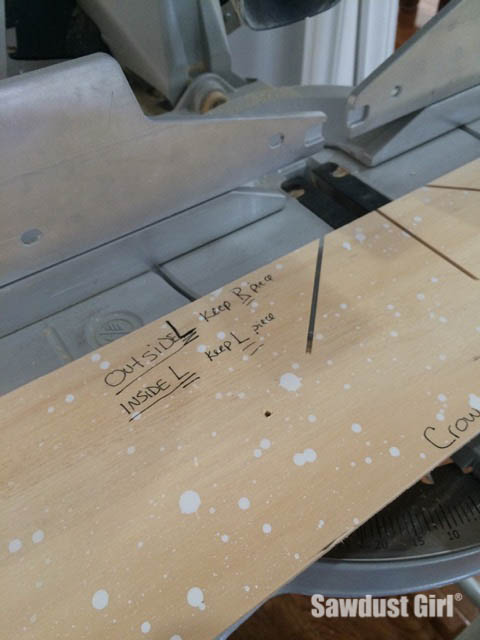
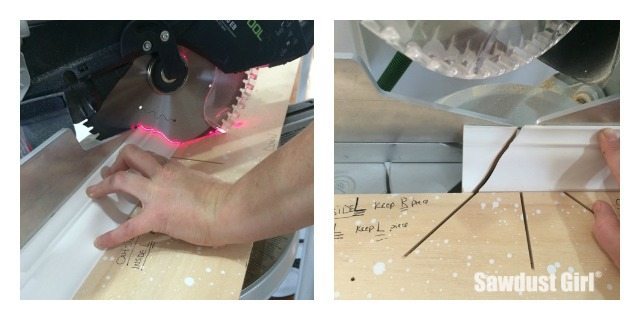
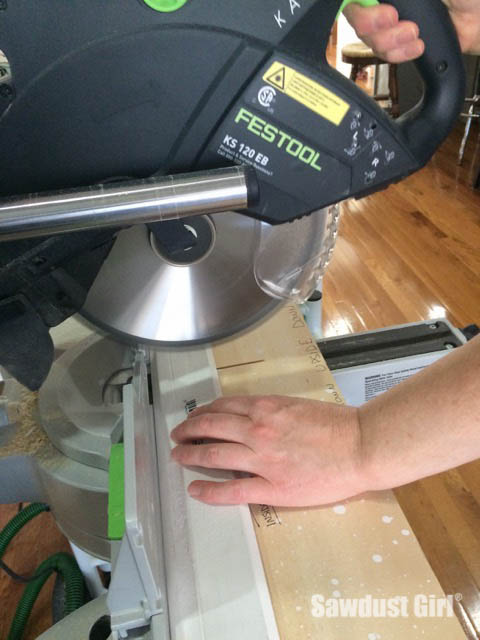
Heidi says
I love your guides. Thanks for posting them! Do you love your Festools Miter Saw? Is it worth the investment?
Sandra says
I love my Kapex. I have heard great things about the Bosch miter saws too and would definitely check them out. They are quite a bit less expensive than Festool and might be a great option.
Brandon says
Thanks for the detailed tips once again!
Bob says
Great guide. You are correct though most DIYers are scared to do crown. But your guide is awesome and helpful.
Kim SaWYER says
I am just blown away with your abilities. How did you learn to do all this. I want to learn woodworking SO BAD but there are no classes anywhere!! Help! I want to learn about tools and what they do.
How to do cuts, just learn everything i can. Do you know of any classes for beginners who want to learn like me??
paula says
Hey, great tutorial! I’m confused about one thing….I’ve been cutting and installing crown in my kitchen. Since you are cutting the crown upside down and backwards, wouldn’t the left inside corner keep the right piece of crown once you cut it? (referring to your “Inside Left, keep left”section of your chart). I sat with a sample and tried this over and over and still come up with keeping the crown to the right of the blade for and inside left corner. I know you did a tutorial for cutting crown on the flat but since this one is for cutting on the spring I thought I’d double check.
Sandra says
Well I’m not cutting crown right now so I can’t visualize what the trouble is. I can’t look at my own pictures and see how the left piece of that cut would look once it’s flipped upside down. Which is why I have to make guides when I do crown! LOL
BUT that is the actual guide that I was using to cut and install crown when I took the photos for this tutorial so I know it works as explained. You should be able to create templates for all the corners the same as in my “lay it flat” tutorial. Then you can use the templates to make sense of each cut.
Sandra says
It depends on if you’re doing an inside or outside corner.
Harry says
Love the tutorial, but I have to agree with Paula. With the crown molding upside down and the miter saw swung to the right, the piece on the right becomes the left inside corner piece.
Sandra says
If you are doing an inside or outside corner changes which piece of the cut you use.
MikeB says
Brilliant!
Dave says
Great tutorial, but there is an error on the template. Your “Inside L” and “Inside R” should be switched. The way it’s written would represent the board and not the joint … although, some people do refer to it that way because they find it easier to think about the board as opposed to the joint. Assuming you want your template to be consistent, and refer to the joint; the left side of the template should read “Inside R Keep L Piece” and subsequently, the right side should read “Inside L Keep R”.
Sandra says
The crown moulding is cut upside down against the template. So saying, “Inside LEFT – Keep RIGHT piece” …when you turn the crown moulding right side up, the RIGHT piece becomes the left side of the joint.